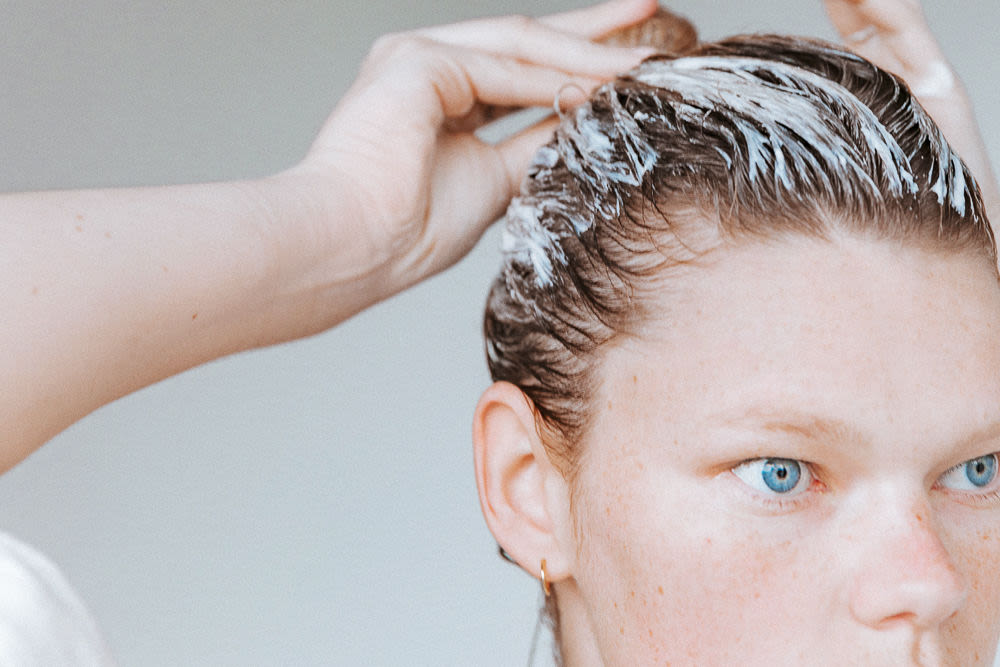It’s winter, which means your morning commute is dusted with snow and so are all your black sweaters, keyboard, and the hair in your brush... No, wait, that’s from your scalp. You might be wondering: how come every January you turn into Allison from The Breakfast Club? The answer isn’t as straightforward as it seems. You might be right to suspect dandruff, but you could also just be dry. (They’re actually different things.) “Both dandruff and dry scalp share main symptoms,” says dermatologist Dr. Michele Green, “but knowing which condition you have makes it easier for you to determine the right treatment.”
One way to tell the difference is the the flakes themselves. What do yours look like? “Flakes from dandruff are oily, large, and either yellow or white,” says Dr. Green. “In dry scalp you’ll notice smaller, drier flakes.” If you still can’t tell, Dr. Green suggests a little overnight test. “Apply a light moisturizer to your scalp before bed. If the flakes are due to dry scalp, they should disappear once you shower the next day.” Test it on yourself tonight—don’t worry, this story will still be here in the morning. Have you figured it out? Great! Let’s move on to some solutions.
Dry Scalp
The cause: “When your skin doesn’t have enough moisture,” explains Dr. Green, “your scalp becomes excessively dry. In return, the skin becomes irritated and flakes start to appear and shed off.” Trichologist (that’s a certified scalp expert) Michelle Blaisure adds that everything from external factors like dry air and a high-pH shampoo, to internal ones like psoriasis, diet, and hormonal imbalances can trigger a dry scalp. “Using too many hair styling products can trigger dry scalp as well,” says Dr. Green.
The fix: Just like you would treat your skin in the wintertime, use things that are simple and moisturizing—lay off any extras you can go without, and stick to the basics. “A gentle shampoo followed by a moisturizing conditioner is helpful if you have a dry scalp,” says Dr. Green. Blaisure adds that these products should have a pH under 6.8. (You can buy pH indicator strips for cheap, if you want to be super extra.) The skin on your head is still skin, and it’s naturally slightly acidic—a low pH will keep a happy balance without stripping. Sulfate-free and color safe are always good indicators a shampoo is gentle, too, and you could even try a co-wash. To those with fine hair it might sound crazy, but that extra moisture might be just what your scalp needs. A clarifying treatment every so often (once a week, suggests Blaisure) keeps your scalp from accumulating buildup. And to treat it from the inside out, Blaisure recommends making sure you’re getting enough omega 3 fatty acids in your diet. “Salmon, walnuts, and flax seeds are all good sources of omega 3s,” she says.
Oily Scalp
The cause: If the skin on your face is oily, then there’s a good chance your scalp will be, too. And dandruff is actually caused by an excess of oil—it gets trapped under layers of dead skin, causing it to flake off in patches. “Dandruff is most commonly associated with a scalp condition known as seborrheic dermatitis,” explains Blaisure. Also known as “cradle cap” because it’s common on babies, seborrhea causes oily patches of red, scaly skin. And it doesn’t just affect your scalp! “Seborrheic dermatitis can develop anywhere you have oil glands,” explains Dr. Green, including your armpits and face. Less common causes of dandruff are high amounts of a fungus called Malassezia, which can cause the skin cells to accumulate more rapidly than normal, and not shampooing enough. Bad news for those trying to prolong a blowout.
The fix: To treat an oily, flaky scalp, Dr. Green recommends using a shampoo that’s specifically formulated for dandruff. You might want to start with something that contains salicylic acid to gently slough away dead skin that might be causing an oil buildup—Dr. Green recommends Neutrogena T/Gel. If that doesn’t work, your next line of defense are antifungals. Things with pyrithione zinc or selenium sulfide kill the fungus on the scalp to remove flakes,” says Dr. Green, “and tea tree oil is a natural alternative with antifungal properties.” Another route is using Nizoral Shampoo a few times a week as a clarifying treatment. And when all else fails, you can ask your dermatologist for a topical steroid solution. Your dandruff should resolve within a few weeks.
Photo via ITG

